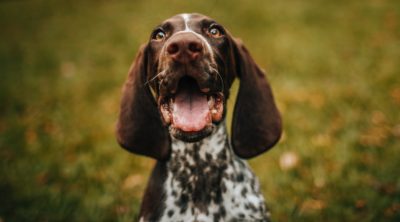
Dogs, cats, foxes, bears, raccoons, rodents, etc., are some of the many animals that have paws. This DogAppy write-up focuses on the anatomy of a dog’s paw.
Dogs don’t sweat like humans. They have far fewer sweat glands than humans. Dogs have sweat glands in their paw pads called merocrine glands. Even so, dogs rarely sweat through their paws. You’ll see it more if a dog is stressed, you might find your dog leave behind a trail of wet footprints.

Dogs are a digitigrade species, which means that they walk on their toes, unlike plantigrade animals that walk on the entire sole of their feet. The terms ‘forelimbs’ and hind limbs’ of a dog refer to its front and hind legs. The main function of their limbs is locomotion. Besides locomotion, their paws also help them scratch. In some breeds, the paws also help in digging. The six pads that are present on a dog’s paw act like a protective cushion, absorbing shock, and protecting the bones and joints.

The structure of their paws could vary, depending on their environment. For instance, Field Spaniels, Portuguese water dogs, or Chesapeake Bay retrievers have webbed feet that allow them to swim. On the other hand, working breeds have thicker toe pads that provide traction. Though both cats and dogs have paws, dogs cannot hold their prey with their paws like cats. They cannot move their toes independently. However, breeds like Keeshonds, Akitas, and Doberman Pinschers have rounder, compact feet. Some dogs have hare feet, which means that the two toes at the center are longer than the outer toes. Greyhounds and Whippets have hare feet, which makes them more agile.
Anatomy of a Dog’s Paw

Here is a list of anatomical structures that make up a dog’s paw:
✦ Claws
✦ Digital pads (4 pads that are located directly under the toes)
✦ Metacarpal pad (A large pad that is located directly under the digital pads)
✦ Dewclaw (A vestigial digit)
✦ Carpal pad (A tiny pad near the wrist)
Claws
Claws, which are basically toenails, are located at the end of each toe. Made up of a protein called keratin, a toenail is the horny, beak-shaped covering of the distal phalanx. Nails grow on the ungual process located on the distal phalanx. These help dogs get a good grip on a surface. These also help the dogs scratch the ground. The toenails have a blood supply that feeds the cuticle, but the end of the nails is dead tissue. The claws grow at a rapid rate, which is why these should be clipped. Clipping them at regular intervals can help avoid an injury.
Dewclaw
Many dogs have a fifth nail and a pad on the inner side of the pastern, which is the region between the fetlock and the hoof. Referred to as the dewclaw, this claw is considered to be a vestigial structure. In most breeds, dewclaws are present on the inside of the front legs, but some breeds might have dewclaws on their hind legs. Since these are vestigial, some dog owners have them removed surgically when their dog is young. Surgical removal is especially considered in breeds where the dewclaw never comes in contact with the ground.
Digital Pads
Located closest to the toenails or claws are four load-bearing digital pads. The support the weight placed on the phalanges. While the thick layer of subcutaneous adipose tissue on the paw pads helps absorb shock and acts as a protective cushion, the surface of the paw pads is protected by conical papillae (extensions of the stratum corneum of the epidermis, which is the outermost layer of the skin). In severe cases, when the dog has been walking on very hard or rough surfaces, these papillae can wear down. Under such circumstances, the dog is likely to experience pain.
Metacarpal/Metatarsal pad
This is the largest paw pad that is located under the digital pads. Like the other paw pads, metacarpal pad provides shock absorption, as well as traction. Traction refers to the friction between the body and the surface. Thicker pads are more effective at absorbing shock. On the other hand, dogs with rough pads are well equipped to take quick turns or sprint, due to improved traction.
Carpal Pad
The carpal pads are located on the front paws at the back of the foot. Unlike the digital pads and the metacarpal pad that bear the load, and act as shock absorbers when the dog walks or runs, the carpal pad helps the dog maintain balance on a steep surface or a slippery slope.
On a concluding note, the paws perform a vital function in dogs. If you have a pet dog, make sure that the claws are clipped as and when needed, and that they look healthy. If your dog has been licking its paws every now and then, check them for cracks, cuts, abrasions, bleeding, or swelling. Allergies, dryness, boredom, anxiety, parasitic infections, bacterial infections, injuries, hormonal imbalances, pain, or conditions related to the joints or nails could be contributing factors for licking.









